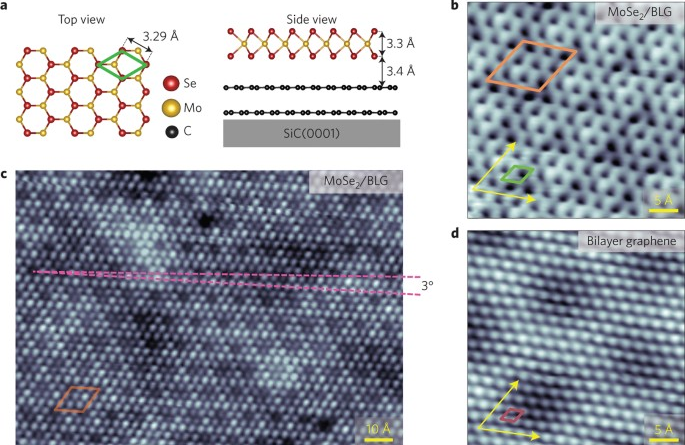Giant bandgap renormalization and excitonic effects in a monolayer transition metal dichalcogenide semiconductor – Nature.com
Thank you for visiting nature.com. You are using a browser version with limited support for CSS. To obtain the best experience, we recommend you use a more up to date browser (or turn off compatibility mode in Internet Explorer). In the meantime, to ensure continued support, we are displaying the site without styles and JavaScript.
Advertisement
Nature Materials volume 13, pages 1091–1095 (2014)
50k
1430
14
Metrics details
Two-dimensional (2D) transition metal dichalcogenides (TMDs) are emerging as a new platform for exploring 2D semiconductor physics1,2,3,4,5,6,7,8,9. Reduced screening in two dimensions results in markedly enhanced electron–electron interactions, which have been predicted to generate giant bandgap renormalization and excitonic effects10,11,12,13. Here we present a rigorous experimental observation of extraordinarily large exciton binding energy in a 2D semiconducting TMD. We determine the single-particle electronic bandgap of single-layer MoSe2 by means of scanning tunnelling spectroscopy (STS), as well as the two-particle exciton transition energy using photoluminescence (PL) spectroscopy. These yield an exciton binding energy of 0.55 eV for monolayer MoSe2 on graphene—orders of magnitude larger than what is seen in conventional 3D semiconductors and significantly higher than what we see for MoSe2 monolayers in more highly screening environments. This finding is corroborated by our ab initio GW and Bethe–Salpeter equation calculations14,15 which include electron correlation effects. The renormalized bandgap and large exciton binding observed here will have a profound impact on electronic and optoelectronic device technologies based on single-layer semiconducting TMDs.
This is a preview of subscription content, access via your institution
Subscribe to this journal
Receive 12 print issues and online access
251,40 € per year
only 20,95 € per issue
Buy this article
Prices may be subject to local taxes which are calculated during checkout
Mak, K. F. et al. Atomically thin MoS2: A new direct-gap semiconductor. Phys. Rev. Lett. 105, 136805 (2010).
Article Google Scholar
Splendiani, A. et al. Emerging photoluminescence in monolayer MoS2 . Nano Lett. 10, 1271–1275 (2010).
Article CAS Google Scholar
Mak, K. F., He, K. L., Shan, J. & Heinz, T. F. Control of valley polarization in monolayer MoS2 by optical helicity. Nature Nanotech. 7, 494–498 (2012).
Article CAS Google Scholar
Zeng, H. L. et al. Valley polarization in MoS2 monolayers by optical pumping. Nature Nanotech. 7, 490–493 (2012).
Article CAS Google Scholar
Cao, T. et al. Valley-selective circular dichroism of monolayer molybdenum disulphide. Nature Commun. 3, 1882 (2012).
Google Scholar
Jones, A. M. et al. Optical generation of excitonic valley coherence in monolayer WSe2 . Nature Nanotech. 8, 634–638 (2013).
Article CAS Google Scholar
Britnell, L. et al. Strong light–matter interactions in heterostructures of atomically thin films. Science 340, 1311–1314 (2013).
Article CAS Google Scholar
Mak, K. F. et al. Tightly bound trions in monolayer MoS2 . Nature Mater. 12, 207–211 (2013).
Article CAS Google Scholar
Zhang, Y. et al. Direct observation of the transition from indirect to direct band gap in atomically-thin epitaxial MoSe2 . Nature Nanotech. 9, 111–115 (2014).
Article CAS Google Scholar
Cheiwchanchamnangij, T. & Lambrecht, W. R. L. Quasiparticle band structure calculation of monolayer, bilayer, and bulk MoS2 . Phys. Rev. B 85, 205302 (2012).
Article Google Scholar
Ramasubramaniam, A. Large excitonic effects in monolayers of molybdenum and tungsten dichalcogenides. Phys. Rev. B 86, 115409 (2012).
Article Google Scholar
Komsa, H. P. & Krasheninnikov, A. V. Effects of confinement and environment on the electronic structure and exciton binding energy of MoS2 from first principles. Phys. Rev. B 86, 241201 (2012).
Article Google Scholar
Qiu, D. Y., da Jornada, F. H. & Louie, S. G. Optical spectrum of MoS2: Many-body effects and diversity of exciton states. Phys. Rev. Lett. 111, 216805 (2013).
Article Google Scholar
Hybertsen, M. S. & Louie, S. G. Electron correlation in semiconductors and insulators: band-gaps and quasi-particle energies. Phys. Rev. B 34, 5390–5413 (1986).
Article CAS Google Scholar
Rohlfing, M. & Louie, S. G. Electron–hole excitations and optical spectra from first principles. Phys. Rev. B 62, 4927–4944 (2000).
Article CAS Google Scholar
Radisavljevic, B., Radenovic, A., Brivio, J., Giacometti, V. & Kis, A. Single-layer MoS2 transistors. Nature Nanotech. 6, 147–150 (2011).
Article CAS Google Scholar
Bernardi, M., Palummo, M. & Grossman, J. C. Extraordinary sunlight absorption and one nanometer thick photovoltaics using two-dimensional monolayer materials. Nano Lett. 13, 3664–3670 (2013).
Article CAS Google Scholar
Gutierrez, H. R. et al. Extraordinary room-temperature photoluminescence in triangular WS2 monolayers. Nano Lett. 13, 3447–3454 (2013).
Article CAS Google Scholar
Wang, F., Dukovic, G., Brus, L. E. & Heinz, T. F. The optical resonances in carbon nanotubes arise from excitons. Science 308, 838–841 (2005).
Article CAS Google Scholar
Scholes, G. D. & Rumbles, G. Excitons in nanoscale systems. Nature Mater. 5, 683–696 (2006).
Article CAS Google Scholar
Mallet, P. et al. Electron states of mono- and bilayer graphene on SiC probed by scanning-tunneling microscopy. Phys. Rev. B 76, 041403 (2007).
Article Google Scholar
Hor, Y. S. et al. p-type Bi2Se3 for topological insulator and low-temperature thermoelectric applications. Phys. Rev. B 79, 195208 (2009).
Article Google Scholar
Feenstra, R. M. & Stroscio, J. A. Tunneling spectroscopy of the GaAs(110) surface. J. Vac. Sci. Technol. B 5, 923–929 (1987).
Article CAS Google Scholar
Ross, J. S. et al. Electrical control of neutral and charged excitons in a monolayer semiconductor. Nature Commun. 4, 2498 (2013).
Article Google Scholar
Deslippe, J. et al. BerkeleyGW: A massively parallel computer package for the calculation of the quasiparticle and optical properties of materials and nanostructures. Comput. Phys. Commun. 183, 1269–1289 (2012).
Article CAS Google Scholar
Lischner, J., Vigil-Fowler, D. & Louie, S. G. Physical origin of satellites in photoemission of doped graphene: An ab Initio GW plus cumulant study. Phys. Rev. Lett. 110, 146801 (2013).
Article Google Scholar
Helveg, S. et al. Atomic-scale structure of single-layer MoS2 nanoclusters. Phys. Rev. Lett. 84, 951–954 (2000).
Article CAS Google Scholar
Zhang, C. et al. Direct imaging of band profile in single layer MoS2 on graphite: Quasiparticle energy gap, metallic edge states, and edge band bending. Nano Lett. 14, 2443–2447 (2014).
Article CAS Google Scholar
Brar, V. W. et al. Scanning tunneling spectroscopy of inhomogeneous electronic structure in monolayer and bilayer graphene on SiC. Appl. Phys. Lett. 91, 122102 (2007).
Article Google Scholar
Mallet, P. et al. Role of pseudospin in quasiparticle interferences in epitaxial graphene probed by high-resolution scanning tunneling microscopy. Phys. Rev. B 86, 045444 (2012).
Article Google Scholar
Horcas, I. et al. WSXM: A software for scanning probe microscopy and a tool for nanotechnology. Rev. Sci. Instrum. 78, 013705 (2007).
Article CAS Google Scholar
Download references
Research supported by Office of Basic Energy Sciences, Department of Energy Early Career Award No. DE-SC0003949 (optical measurements), and by the sp2 Program (STM instrumentation development and operation), the Theory Program (GW–BSE calculations), and the SciDAC Program on Excited State Phenomena in Energy Materials (algorithms and codes) which are funded by the US Department of Energy, Office of Basic Energy Sciences and of Advanced Scientific Computing Research, under Contract No. DE-AC02-05CH11231. Support also provided by National Science Foundation award no. 1235361 (image analysis) and National Science Foundation award no. DMR10-1006184 (substrate screening theory and calculations). Computational resources have been provided by the NSF through XSEDE resources at NICS and DOE at NERSC. A.J.B. was supported by the Department of Defense (DoD) through the National Defense Science & Engineering Graduate Fellowship (NDSEG) Program. W. R acknowledges support from the Chinese Scholarship Council (No. 201306210202). D.Y.Q. acknowledges support from NSF Graduate Research Fellowship Grant No. DGE 1106400 and S.G.L. acknowledges support of a Simons Foundation Fellowship in Theoretical Physics. STM/STS data were analysed and rendered using WSxM software31. S-F.S. and F.W. acknowledge X. Hong and J. Kim for technical help.
Miguel M. Ugeda, Aaron J. Bradley and Su-Fei Shi: These authors contributed equally to this work.
Department of Physics, University of California at Berkeley, Berkeley, California 94720, USA
Miguel M. Ugeda, Aaron J. Bradley, Su-Fei Shi, Felipe H. da Jornada, Diana Y. Qiu, Wei Ruan, Feng Wang, Steven G. Louie & Michael F. Crommie
Materials Sciences Division, Lawrence Berkeley National Laboratory, Berkeley, California 94720, USA
Felipe H. da Jornada, Diana Y. Qiu, Feng Wang, Steven G. Louie & Michael F. Crommie
Advanced Light Source, Lawrence Berkeley National Laboratory, Berkeley, California 94720, USA
Yi Zhang, Sung-Kwan Mo & Zahid Hussain
Stanford Institute for Materials and Energy Sciences, SLAC National Accelerator Laboratory, Menlo Park, California 94025, USA
Yi Zhang & Zhi-Xun Shen
Department of Physics, State Key Laboratory of Low Dimensional Quantum Physics, Tsinghua University, Beijing 100084, China
Wei Ruan
Departments of Physics and Applied Physics, Geballe Laboratory for Advanced Materials, Stanford University, Stanford, California 94305, USA
Zhi-Xun Shen
Kavli Energy NanoSciences Institute at the University of California Berkeley and the Lawrence Berkeley National Laboratory, Berkeley, California 94720, USA
Feng Wang & Michael F. Crommie
You can also search for this author in PubMed Google Scholar
You can also search for this author in PubMed Google Scholar
You can also search for this author in PubMed Google Scholar
You can also search for this author in PubMed Google Scholar
You can also search for this author in PubMed Google Scholar
You can also search for this author in PubMed Google Scholar
You can also search for this author in PubMed Google Scholar
You can also search for this author in PubMed Google Scholar
You can also search for this author in PubMed Google Scholar
You can also search for this author in PubMed Google Scholar
You can also search for this author in PubMed Google Scholar
You can also search for this author in PubMed Google Scholar
You can also search for this author in PubMed Google Scholar
M.M.U., A.J.B., S-F.S., F.W. and M.F.C. conceived the work and designed the research strategy. M.M.U. and A.J.B. measured and analysed the STM/STS data in collaboration with W.R. for the MoSe2/HOPG experiments. S-F.S. carried out the photoluminescence and Raman experiments. F.H.d.J. and D.Y.Q. performed the theoretical calculations. Y.Z. and S-K.M. performed the MBE growth and characterization (LEED, RHEED, core-level spectroscopy) of the samples. Z.H. and Z-X.S. supervised the MBE and sample characterization. F.W. supervised the optical measurements. S.G.L. supervised the theoretical calculations. M.F.C. supervised the STM/STS experiments. M.M.U. wrote the paper with help from A.J.B. and M.F.C. M.M.U. and M.F.C. coordinated the collaboration. All authors contributed to the scientific discussion and manuscript revisions.
Correspondence to Miguel M. Ugeda or Michael F. Crommie.
The authors declare no competing financial interests.
Supplementary Information (PDF 3748 kb)
Reprints and permissions
Ugeda, M., Bradley, A., Shi, SF. et al. Giant bandgap renormalization and excitonic effects in a monolayer transition metal dichalcogenide semiconductor. Nature Mater 13, 1091–1095 (2014). https://doi.org/10.1038/nmat4061
Download citation
Received:
Accepted:
Published:
Issue Date:
DOI: https://doi.org/10.1038/nmat4061
Anyone you share the following link with will be able to read this content:
Sorry, a shareable link is not currently available for this article.
Provided by the Springer Nature SharedIt content-sharing initiative
Nature Communications (2024)
Nature Reviews Materials (2023)
npj Computational Materials (2023)
Light: Science & Applications (2023)
npj Computational Materials (2023)
Advertisement
© 2024 Springer Nature Limited
Sign up for the Nature Briefing newsletter — what matters in science, free to your inbox daily.


